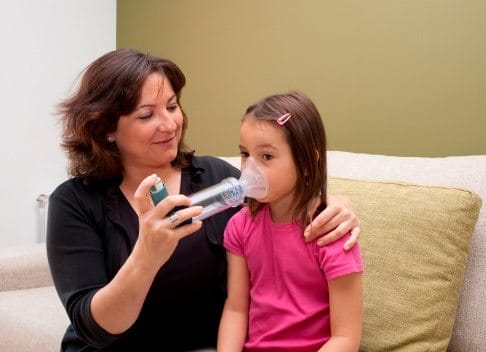A wide-ranging report from the National Academies of Sciences, Engineering and Medicine is calling for better national statistics, education, access to treatment and awareness for food allergies.
Specifically, the report recommends that the U.S. Food and Drug Administration, the Centers for Disease Control and Prevention, the Federal Aviation Administration and other relevant federal agencies convene a special task force within a year to develop and implement policy guidelines that ensure emergency epinephrine becomes widely available in public venues, all school settings and places such as commercial flights. It also calls for guidelines to train school and university health staff, early care and education providers and on-board flight crews.
Dr. Virginia Stallings, a pediatrician at the Children’s Hospital of Philadelphia who chaired the report committee, says that while the National Academies is an advisory body that doesn’t have authority to force any changes, its recommendations are usually carefully considered by national government agencies.
“I think in this report – particularly because we had a combination of interested federal sponsors and non-federal sponsors – that just launching this report reflected interest among many stakeholders, and the committee very much made recommendations to get this done.”
The report, called “Finding a Path to Safety in Food Allergy,” is the outcome of a project initiated in 2013 by the Food Allergy Research & Education (FARE) organization. It involved the work of 15 committee members and had 11 sponsors, including the Food and Drug Administration, the Food and Nutrition Service of the U.S. Department of Agriculture and the National Institute of Allergy and Infectious Diseases. Other sponsors were from industry and allergy groups, including FARE and the Asthma and Allergy Foundation of America. An advisory panel of nine parents of kids with food allergies and one person living with food allergies also informed the committee.
In its report, released November 30, 2016, the committee makes a strong call for better statistics on how many people are affected by food allergies. “That is part of how the medical and public health community evaluates the importance of a disease,” explains Stallings.
In a public webinar, committee member Dr. Hugh Sampson from the Icahn School of Medicine at Mount Sinai in New York, explained that, in reviewing the research data, the committee found there weren’t strong prevalence statistics in the United States. He said such data are necessary “because this helps us to prioritize food allergy as a public health problem, it also helps direct appropriate resources, and also helps us assess the risks in different populations.”
The committee called for the Centers for Disease Control and Prevention (CDC) to obtain prevalence estimates in a “systematic and statistically sound manner.” Specifically, it suggests the current National Health and Nutrition Examinations Survey database could be employed. Stallings said the numbers should be gathered in such a way that they show prevalence in children and adults, and by specific allergenic foods.
While acknowledging a lack of data, the report in no way discounts the challenges faced by a large population of people living with food allergies. Sampson noted that current prevalence data “ranges from 12 to 15 million Americans, which certainly indicates this is a very major health problem in the country.”
Dr. James Baker*, FARE’s CEO, says his organization welcomes the committee’s recommendations. (Although FARE was a large funder of the study, it did not have any control over the final outcome.) “We were very pleased that the National Academies agreed this is an important and growing health problem that really deserves a much greater health-care emphasis than it has had previously. This should give solace to people who are living with food allergies – finally, there is a recognition from the federal government that this is an enormous problem.”
The National Academies report targets everything from medical schools, airlines, all levels of education and restaurants in its thorough recommendations. It calls for the CDC to develop a public health campaign to increase food allergy awareness and empathy, and calls for better training in medical schools about food allergies. “We also want to have additional training for first responders and for emergency rooms because one of the things the committee learned is that even in emergency rooms, there is a reluctance to use the intramuscular epinephrine,” says Stallings.
When it comes to restaurants, the National Academies committee is asking for the leadership in the food-services industry to consider how they can make their establishments safer. “That includes more education of servers and managers in restaurants so that when there is a question about food allergies, we have a well-informed person to answer that question. And also to recognize early signs of a food allergy reaction and to have emergency epinephrine available,” says Stallings.
The committee also addresses confusing precautionary labeling, often referred to as “may contain” statements. It recommends the current voluntary system be replaced with a risk-based approach modeled after one used in Australia and New Zealand. In the public webinar, Dr. Stephen Taylor from the University of Nebraska said the committee did not endorse the threshold levels for allergy safety used in those countries, but suggested there was sufficient data to establish such reference doses in the U.S.
In a press release, FARE noted that in past it has recommended against thresholds for allergens in packaged goods, unless reliable scientific data show that a proposed quantity is small enough to be safe for “even the most sensitive individuals.” But it will work with the FDA and other stakeholders to evaluate such data with the general aim of working toward more helpful allergen labeling.
The committee also questioned whether some nuts currently on the allergen priority list, like beech nut, chestnut and coconut have merit, and suggests sesame seed as a potential addition to the list. (This is a move FARE has supported.)
When asked if the committee’s recommendations, particularly in terms of emergency epinephrine in places like airplanes, are feasible, Baker pointed to upcoming FDA and airline re-authorization bills “that could make a real start on at least the training aspects and just getting them to document in the medical kit how to use the epinephrine that’s already there.” While he acknowledges epinephrine auto-injector affordability continues to be a challenge for getting them placed in airplanes, “as we get longer-lasting devices, that will be doable as well.”
Further Recommendations and Findings
– The committee acknowledges that there is no simple way to diagnose food allergies, and that it must be done with a combination of medical history, physical exam and testing, which usually includes skin-prick test, food-specific serum immunoglobulin E (IgE) test, food elimination diet and when appropriate, oral food challenge. It recommends avoiding non-standardized and unproven procedures, such as applied kinesiology, immunoglobulin G panels and electrodermal testing.
– Because current auto-injectors containing 0.15 mg or 0.30 mg of epinephrine are not designed for infants, it recommends the FDA evaluate the need for an auto-injector with 0.075 mg of epinephrine for this group of tiny patients.
– The committee says there is no strong evidence to say that any of the following prevent food allergy: avoiding allergens when pregnant or breastfeeding, avoiding allergens in infancy, vaginal delivery, breastfeeding, infant formulas with partially or extensively hydrolyzed proteins, and supplementing with nutrients like vitamin D.
– The committee supports introduction of all foods, including those considered potentially allergenic, to infants around 6 months of age, and not before 4 months of age.
– It was beyond the scope of the report to assess experimental desensitization therapies, such as oral immunotherapy (OIT), but the committee recommends that work continue.
– The report also says organizations that train people in first aid, such as the American Red Cross and the National Safety Council, should include food allergy and anaphylaxis management in their courses.
View the full report here.
*Dr. Baker left FARE in 2018. Lisa Gable is now the CEO.







